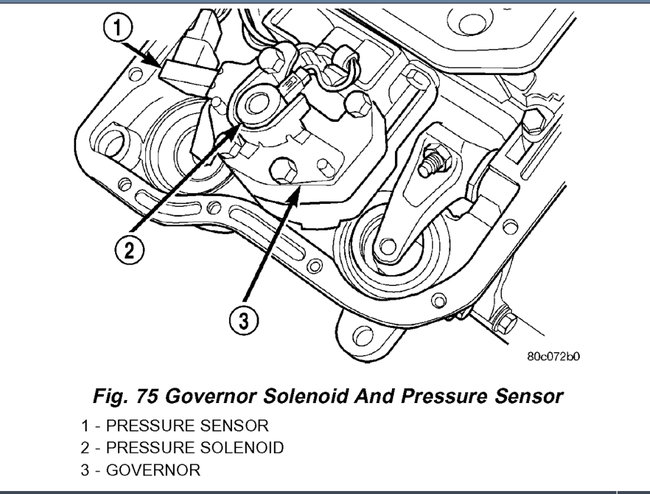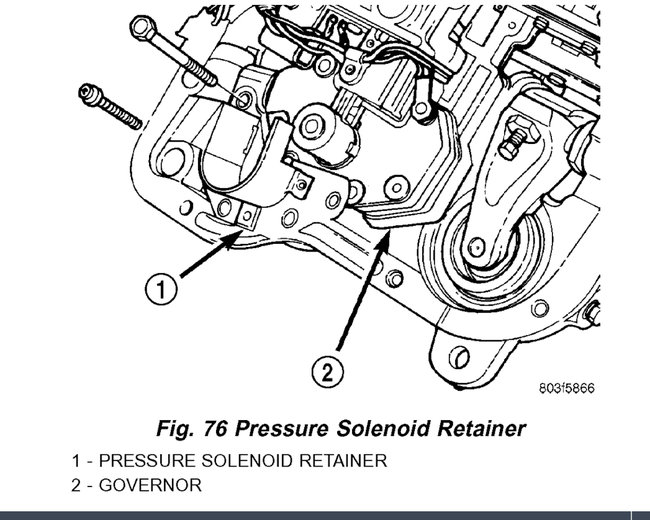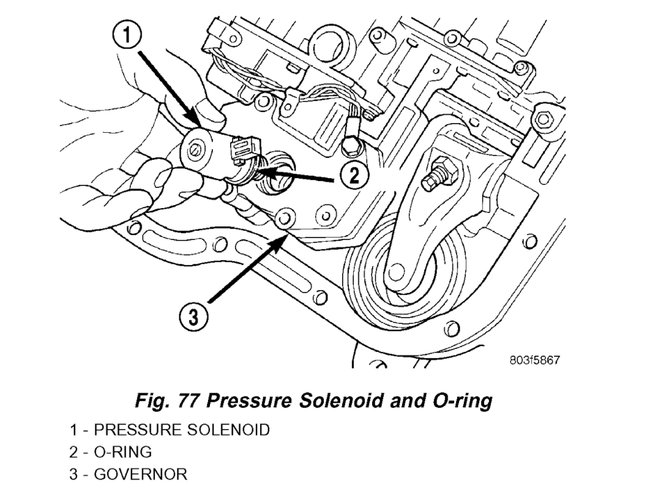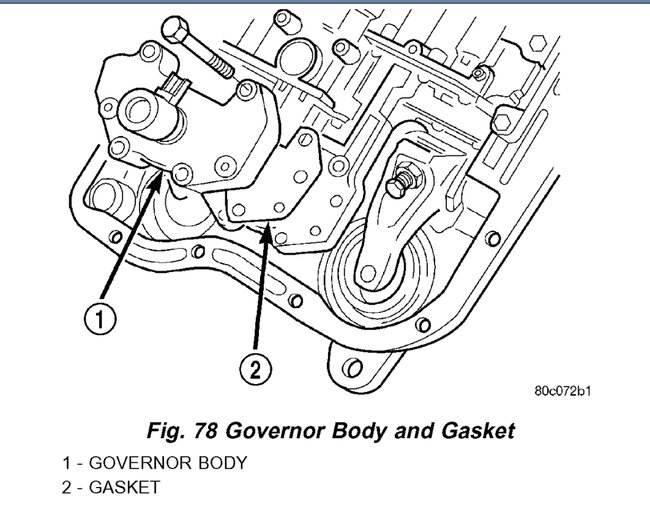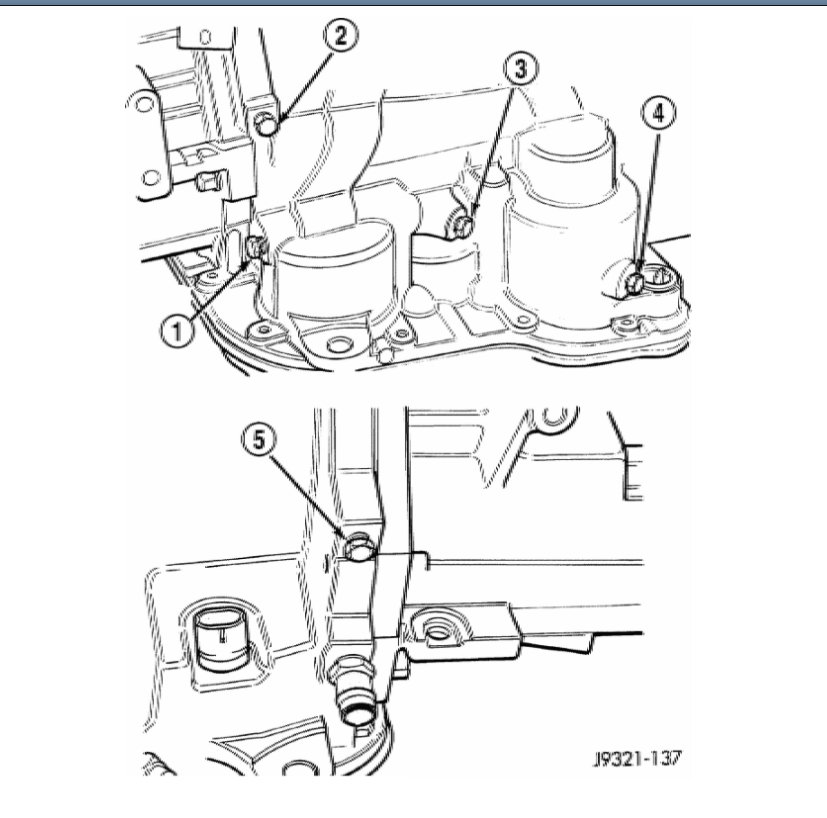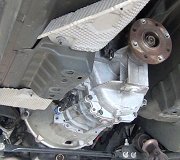Good afternoon,
If there are no codes, it is not electronic. It is mechanical. It could be the valve body that has valves that are sticking.
https://www.2carpros.com/articles/automatic-transmission-problems
A common issue os the governor as that controls the shifting. I would have it checked as they need to test the actual pressure to the governor in order for it to command shifting.
Roy
REMOVAL
1. Hoist and support vehicle on safety stands.
2. Remove transmission fluid pan and filter.
imageOpen In New TabZoom/Print
3. Disengage wire connectors from pressure sensor and solenoid (Fig. 75).
4. Remove screws holding pressure solenoid retainer to governor body.
imageOpen In New TabZoom/Print
5. Separate solenoid retainer from governor (Fig. 76).
imageOpen In New TabZoom/Print
6. Pull solenoid from governor body (Fig. 77).
7. Pull pressure sensor from governor body.
8. Remove bolts holding governor body to valve body.
imageOpen In New TabZoom/Print
9. Separate governor body from valve body (Fig. 78).
10. Remove governor body gasket.
Testing
1 - REAR SERVO TEST PORT
2 - GOVERNOR TEST PORT
3 - ACCUMULATOR TEST PORT
4 - FRONT SERVO TEST PORT
5 - OVERDRIVE CLUTCH TEST PORT
Test ports are located at both sides of the transmission case
Line pressure is checked at the accumulator port on the right side of the case. The front servo pressure port is at the right side of the case just behind the filler tube opening.
The rear servo and governor pressure ports are at the right rear of the transmission case. The overdrive clutch pressure port is at the left rear of the case.
Test One - Transmission In Manual Low
NOTE:This test checks pump output, pressure regulation, and condition of the rear clutch and servo circuit. Both test gauges are required for this test.
1. Connect tachometer to engine. Position tachometer so it can be observed from driver seat if helper will be operating engine. Raise vehicle on hoist that will allow rear wheels to rotate freely.
2. Connect 100 psi Gauge C-3292 to accumulator port. Then connect 300 psi Gauge C-3293-SP to rear servo port.
3. Disconnect throttle and gearshift cables from levers on transmission valve body manual shaft.
4. Have helper start and run engine at 1000 rpm.
5. Move transmission shift lever fully forward into 1 range.
6. Gradually move transmission throttle lever from full forward to full rearward position and note pressures on both gauges:
- Line pressure at accumulator port should be 54-60 psi (372-414 kPa) with throttle lever forward and gradually increase to 90-96 psi (621-662 kPa) as throttle lever is moved rearward.
- Rear servo pressure should be same as line pressure within 3 psi (20.68 kPa).
Test Two - Transmission In 2 Range
NOTE:This test checks pump output, line pressure and pressure regulation. Use 100 psi Test Gauge C-3292 for this test.
1. Leave vehicle in place on hoist and leave Test Gauge C-3292 connected to accumulator port.
2. Have helper start and run engine at 1000 rpm.
3. Move transmission shift lever one detent rearward from full forward position. This is 2 range.
4. Move transmission throttle lever from full forward to full rearward position and read pressure on gauge.
5. Line pressure should be 54-60 psi (372-414 kPa) with throttle lever forward and gradually increase to 90-96 psi (621-662 kPa) as lever is moved rearward.
Test Three - Transmission In D Range Third Gear
NOTE:This test checks pressure regulation and condition of the clutch circuits. Both test gauges are required for this test.
1. Turn OD switch off.
2. Leave vehicle on hoist and leave Gauge C-3292 in place at accumulator port.
3. Move Gauge C-3293-SP over to front servo port for this test.
4. Have helper start and run engine at 1600 rpm for this test.
5. Move transmission shift lever two detents rearward from full forward position. This is D range.
6. Read pressures on both gauges as transmission throttle lever is gradually moved from full forward to full rearward position:
- Line pressure at accumulator in D range third gear, should be 54-60 psi (372-414 kPa) with throttle lever forward and increase as lever is moved rearward.
- Front servo pressure in D range third gear, should be within 3 psi (21 kPa) of line pressure up to kickdown point.
Test Four - Transmission In Reverse
NOTE:This test checks pump output, pressure regulation and the front clutch and rear servo circuits. Use 300 psi Test Gauge C-3293-SP for this test.
1. Leave vehicle on hoist and leave gauge C-3292 in place at accumulator port.
2. Move 300 psi Gauge C-3293-SP back to rear servo port.
3. Have helper start and run engine at 1600 rpm for test.
4. Move transmission shift lever four detents rearward from full forward position. This is Reverse range.
5. Move transmission throttle lever fully forward then fully rearward and note reading at Gauge C-3293-SP.
6. Pressure should be 145 - 175 psi (1000-1207 kPa) with throttle lever forward and increase to 230 - 280 psi (1586-1931 kPa) as lever is gradually moved rearward.
Test Five - Governor Pressure
NOTE:This test checks governor operation by measuring governor pressure response to changes in vehicle speed. It is usually not necessary to check governor operation unless shift speeds are incorrect or if the transmission will not downshift. The test should be performed on the road or on a hoist that will allow the rear wheels to rotate freely.
1. Move 100 psi Test Gauge C-3292 to governor pressure port.
2. Move transmission shift lever two detents rearward from full forward position. This is D range.
3. Have helper start and run engine at curb idle speed. Then firmly apply service brakes so wheels will not rotate.
4. Note governor pressure:
- Governor pressure should be no more than 20.6 kPa (3 psi) at curb idle speed and wheels not rotating.
- If pressure exceeds 20.6 kPa (3 psi), a fault exists in governor pressure control system.
5. Release brakes, slowly increase engine speed, and observe speedometer and pressure test gauge (do not exceed 30 mph on speedometer). Governor pressure should increase in proportion to vehicle speed. Or approximately 6.89 kPa (1 psi) for every 1 mph.
6. Governor pressure rise should be smooth and drop back to no more than 20.6 kPa (3 psi), after engine returns to curb idle and brakes are applied to prevent wheels from rotating.
7. Compare results of pressure test with analysis chart.
Test Six - Transmission In Overdrive Fourth Gear
NOTE:This test checks line pressure at the overdrive clutch in fourth gear range. Use 300 psi Test Gauge C-3293-SP for this test. The test should be performed on the road or on a chassis dyno.
1. Remove tachometer; it is not needed for this test.
2. Move 300 psi Gauge to overdrive clutch pressure test port. Then remove other gauge and reinstall test port plug.
3. Lower vehicle.
4. Turn OD switch on.
5. Secure test gauge so it can be viewed from drivers seat.
6. Start engine and shift into D range.
7. Increase vehicle speed gradually until 3-4 shift occurs and note gauge pressure.
8. Pressure should be 469-496 kPa (68-72 psi) with closed throttle and increase to 620-827 kPa (90-120 psi) at 1/2 to 3/4 throttle. Note that pressure can increase to around 896 kPa (130 psi) at full throttle.
9. Return to shop or move vehicle off chassis dyno.
Images (Click to make bigger)
Thursday, February 4th, 2021 AT 12:55 PM
